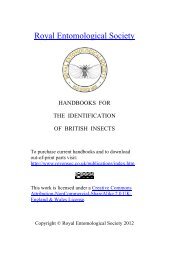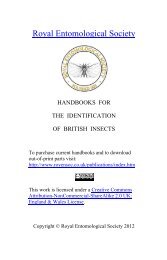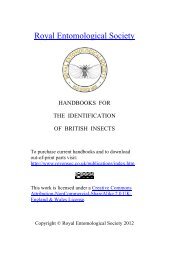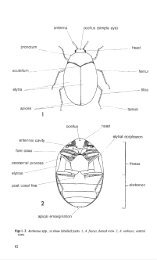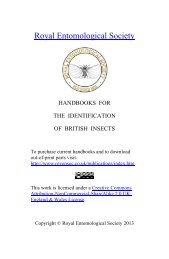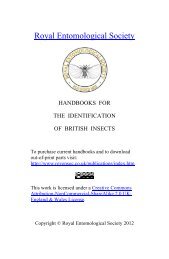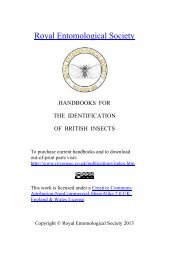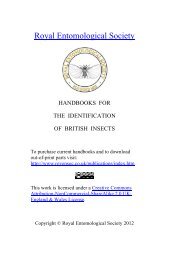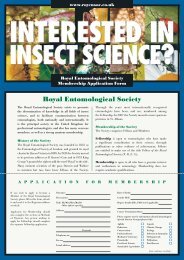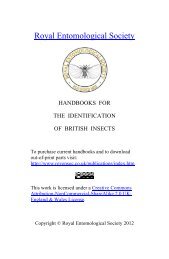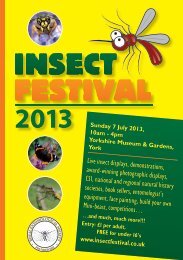Vol 10 Part 14. An introduction to the immature stages of British Flies ...
Vol 10 Part 14. An introduction to the immature stages of British Flies ...
Vol 10 Part 14. An introduction to the immature stages of British Flies ...
Create successful ePaper yourself
Turn your PDF publications into a flip-book with our unique Google optimized e-Paper software.
chromosomes, are being found. The larvae are aquatic and usually found in running<br />
water including rapids and cascades. The three species <strong>of</strong> Prosimulium are found in hill<br />
streams. The commonest species <strong>of</strong> Simulium is S. ornatum Meigen, <strong>the</strong> larvae <strong>of</strong> which<br />
are found in all types <strong>of</strong>lowland water courses and are <strong>of</strong>ten abundant in small streams<br />
and flowing ditches. Simulium vernum Macquart and S. cryophilum Knoz are <strong>of</strong>ten<br />
abundant in many types <strong>of</strong> small streams. S. equinum (L.) is common, usually on rooted<br />
vegetation in large streams with a steady current and is frequently accompanied by S.<br />
lineatum (Meigen). S. reptans (L.) and S. tuberosum Lundstrom are common in larger<br />
s<strong>to</strong>ny rivers but <strong>the</strong> latter occurs usually above <strong>the</strong> limit <strong>of</strong> cultivation <strong>of</strong> <strong>the</strong><br />
surrounding land and <strong>the</strong> former below, though <strong>the</strong>re is an area <strong>of</strong> overlap. O<strong>the</strong>r<br />
species are more specialised in <strong>the</strong>ir habitat and consequently less common, e.g. S.<br />
costatum Friederichs (spring-fed streams near source), S. noelleri Friederichs (lake or<br />
pond outlets).<br />
The larvae are filter feeders on vegetable debris and dia<strong>to</strong>ms which <strong>the</strong>y strain from<br />
<strong>the</strong> water with <strong>the</strong>ir cephalic fans (figs 68-69). Occasionally <strong>the</strong>y may ingest small<br />
larvae such as Chironomidae or even early ins tars <strong>of</strong> <strong>the</strong>ir own kind. There are six <strong>to</strong><br />
eight larval instars in our species. There is a short pharate (see Introduction) stage<br />
(recognised by <strong>the</strong> much darker gill-spot) when <strong>the</strong> prepupa, still inside <strong>the</strong> last larval<br />
skin, spins its cocoon <strong>of</strong> silk, attached <strong>to</strong> a suitable substrate, inside which it pupates.<br />
The pupa has long filamen<strong>to</strong>us gills (fig. 1122).<br />
The eggs are eccentric ovoid in shape (fig. 985) and may be laid singly and loosely or<br />
in batches stuck <strong>to</strong> <strong>the</strong> substrate; <strong>the</strong>y are white when laid but darker later. Many<br />
species pass <strong>the</strong> winter as eggs but some do so as slowly growing larvae.<br />
Most adult female Simuliidae suck blood and <strong>the</strong>ir biting <strong>of</strong> man and animals causes<br />
irritation sometimes followed by <strong>to</strong>xic and allergic reactions. In tropical Africa and<br />
tropical America <strong>the</strong>y transmit <strong>the</strong> disease onchocerciasis (river blindness). In Britain<br />
<strong>the</strong>y are known <strong>to</strong> transmit <strong>the</strong> nema<strong>to</strong>de Onchocerca gutturosa <strong>to</strong> cattle (without<br />
serious results) and certain Pro<strong>to</strong>zoa (e.g. Leucocy<strong>to</strong>zoon) among birds. This medical<br />
and veterinary importance has led <strong>to</strong> a considerable amount <strong>of</strong> work on <strong>the</strong>ir <strong>immature</strong><br />
<strong>stages</strong> for <strong>the</strong> purpose <strong>of</strong> survey and control work throughout <strong>the</strong> world. The Simulium<br />
fauna <strong>of</strong> an area is best established by searching for <strong>the</strong>ir larvae and pupae in freshwater<br />
systems from small trickles <strong>to</strong> large rivers. Thorough surveys such as that <strong>of</strong>Crosskey<br />
(1985) in <strong>the</strong> London area would be worthwhile projects and add much <strong>to</strong> our<br />
knowledge <strong>of</strong> <strong>the</strong> ecology and distribution <strong>of</strong> <strong>the</strong> family.<br />
L. Davies ( 1968) keys <strong>the</strong> <strong>British</strong> species in <strong>the</strong> larval, pupal and adult <strong>stages</strong>, but <strong>the</strong><br />
keys <strong>to</strong> early <strong>stages</strong> are difficult <strong>to</strong> use and are currently under revision by <strong>the</strong><br />
Freshwater Biological Association. Ladle & Bass (1975) have described <strong>the</strong> larva <strong>of</strong> a<br />
new Metacnephia. The Diptera Check List in <strong>the</strong> Handbook series should be consulted<br />
for nomencla<strong>to</strong>rial changes.<br />
<strong>An</strong>isopodidae<br />
(Figs: larvae 70-73, egg 986, pupa 1123)<br />
The family <strong>An</strong>isopodidae contains about <strong>10</strong>0 species in six genera <strong>of</strong> which 5 species<br />
in 2 genera occur in Britain. Two subfamilies are recognised, <strong>the</strong> larvae <strong>of</strong> which may be<br />
separated as follows.<br />
<strong>An</strong>al segment ra<strong>the</strong>r truncate posteriorly; posterior spiracular disc larger and with distinct<br />
lobes (fig. 72); lines drawn through <strong>the</strong> axes <strong>of</strong> <strong>the</strong> diagonal posterior spiracles would<br />
intersect on disc . . . . . . . . . . . . . . . . . . <strong>An</strong>isopodinae<br />
One genus, Sylvicola ( = <strong>An</strong>isopus)<br />
<strong>An</strong>al segment elongated and more rounded posteriorly; posterior spiracular disc small,<br />
without distinct lobes; lines drawn through axes <strong>of</strong> posterior spiracles would not intersect<br />
on disc (fig. 73) . . . . . . . . . . . . . . . . Myce<strong>to</strong>biinae<br />
One genus and species, Myce<strong>to</strong>bia pallipes Meigen<br />
46




